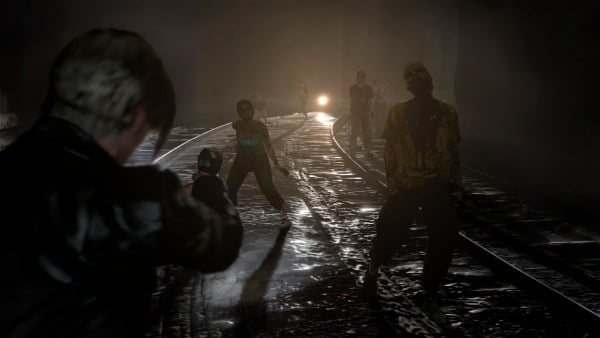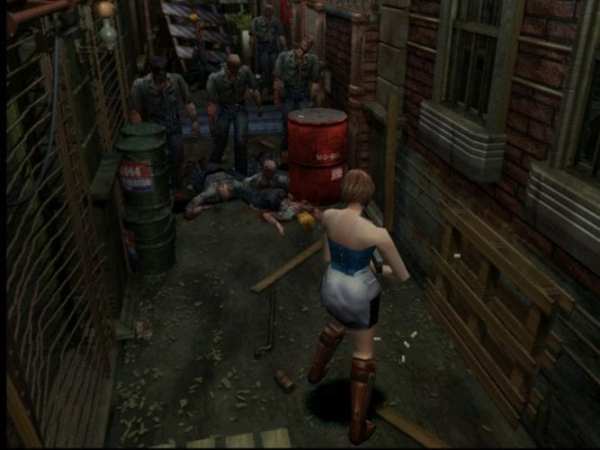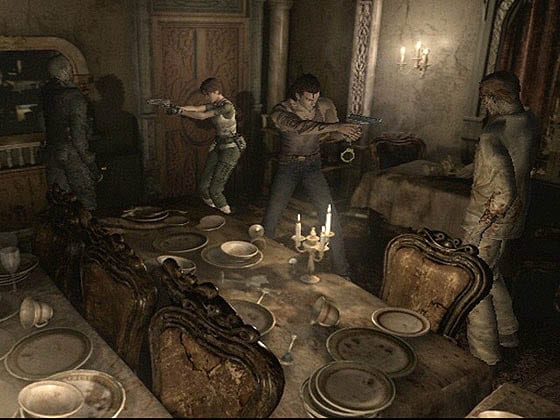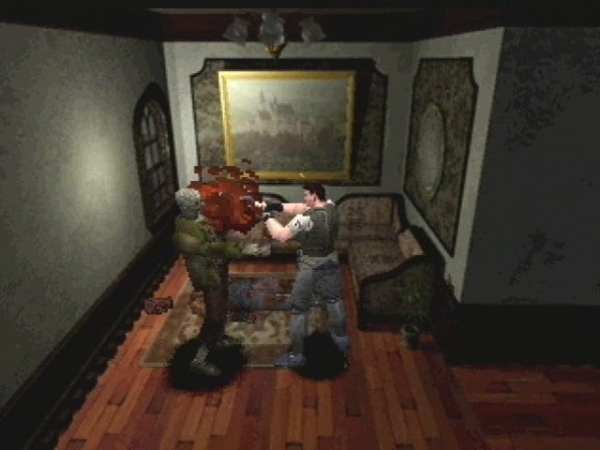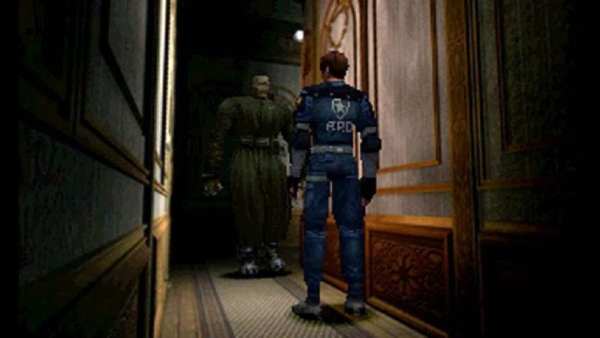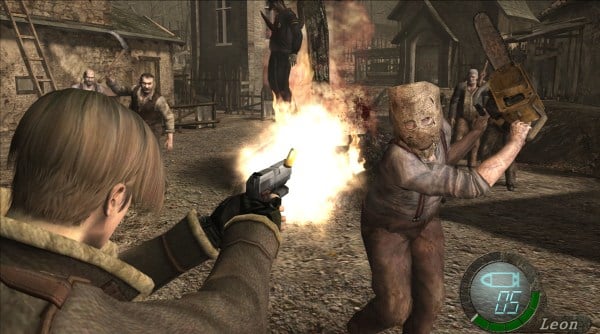8) Resident Evil 5
Resident Evil 5 is by no means a bad video game. It looks great, sounds great, and has great action sequences. So why is it so low on this list? The fifth main title entry in this long running series was meant to build on the incredible success of Resident Evil 4. What fans got instead was a game that was more of a Call of Duty meets Gears of War hybrid skinned in Resident Evil lore and gameplay, rather than a survival horror game.
Action took center stage and the infected were meant to swarm and overwhelm you instead of scaring you. The undead gave their positions away by yelling and charging players, and while the tension certainly built at key points of the game, it was never really the right kind of tension, given that ammo was always available throughout the adventure. The addition of a co-op or AI-controlled partner also took away from the feelings of isolation and lone survival the series built its name on. This was not a horror game. At its best, RE5 was a nail-biting action game. At its worst, it was a monotonous third-person shooter.
7) Resident Evil 6
It wasn’t long after release that fans quickly learned that Capcom hadn’t heard their anguished cries, begging for a true survival horror experience. The campaigns were short but well intertwined, a nod to older games in the series. Their brevity wasn’t the only problem as each campaign was far too focused on the action and failed to make players feel truly hopeless. Ammo may have been more limited than in RE5 but this only hindered Chris and Jake’s campaigns, which were very action-heavy. The absurd emphasis on quick-time action sequences wrestled the controls away from players when things got really exciting, forcing them to watch and mindlessly click random button sequences to fight through the undead when they could instead be playing the game.
That said, RE6 did indeed attempt to recenter the theme of the game around survival horror. Environments were beautifully rendered and appropriately confined in most areas. The mercenary mode and Ada Wong’s solo scenario were also strong this time around. But any fans looking for a true survival horror experience certainly left this one feeling disappointed.
6) Resident Evil 3: Nemesis
The third main title in the series, RE3 was tasked with the impossible: following up the masterpiece that is Resident Evil 2. Instead of focusing on Racoon City and the investigation of what befell the terribly unlucky city as 2 had, RE3 centers around the events occurring 24 hours prior to RE2 and Jill Valentine’s escape from Racoon City. The catch was that the dreadful Nemesis was on your tail the whole time, arguably the sole reason why RE3 is so special.
This monstrosity of a bio-weapon would pursue players down narrow corridors and city streets littered with undead, burning cars, and all kinds of obstacles. The fear of not knowing when this beast would strike next had you clenching your controller as you entered every new area, constantly on edge for fear of being taken by surprise by the Nemesis.
Resident Evil 3 sported subtle refinements to player control and game design, like allowing players to shoot explosive barrels to deal with enemies, and did well to honor the foundations set by its predecessors. For a game that underwent so many development adjustments and redirection, RE3 was a great follow up to RE2 but ultimately failed to surpass its achievements.
5) Resident Evil 0
The prequel to the entire series, Resident Evil 0 put players in the shoes of Rebecca Chambers and Billy Coen, the former a junior S.T.A.R.S. member and the latter a military prisoner with a mysterious past. The two team up to survive the litany of puzzles and monsters in a tense and well-paced survival horror romp worthy of the series name and pedigree.
The fixed camera angles did a better job than ever in directing the focus of the scene, creating blind spots from which enemies would leap out at you or subtly pulling your attention to puzzles and their solutions. The controls and camera forced players to be methodical in their approach, planning their movements and always keeping their own frailty in mind when charting new territory. Ammo and health are limited, and so was inventory space.
Much like the original games, this made your decisions on what to keep and what to let go of all the more difficult. RE0 did well to refine the series’ classic tropes into beloved staples which act as both set limits to player control and awareness, as well as interesting mechanics used to produce a sense of dread. With RE0 getting an HD re-release, there’s no reason not to give this classic a well earned play through.
4) Resident Evil 1
The game that started it all, Resident Evil 1 is a legend in the gaming world. The beloved series got its start way back in 1996 in the confines of the eerily quiet halls, corridors, and hidden tunnels of the Spencer mansion. Zombies shuffled around the rooms looking for their next victim and put up one hell of a fight, forcing players to expend precious ammo and health resources to deal with them, an experience that never lost its edge due to the crippling lack of stocks needed to replenish your inventory throughout the game.
Everything about RE1 was methodically planned and carefully designed. Infected dogs would leap through windows, zombies grabbed at you as you turned the corners of the mansion and cryptic puzzles had players trying to remember where each locked door and missing puzzle piece was. Even saving your progress was a privilege to be earned, not given, as you hunted for Ink Ribbons throughout the mansion.
It’s no understatement to say that this game spawned an entirely new genre of games which took the gaming world by storm and left fans begging for more. This timeless classic has seen numerous HD remakes, with the latest adding entirely new sections, so there’s no reason to miss out on the game that ushered in the age of Resident Evil.
3) Resident Evil: Code Veronica
Originally slated to be the sequel to RE2, Resident Evil: Code Veronica was the series’ first true step forward in terms of gameplay and game design. The environments were no longer pre-rendered backgrounds, bringing the game fully into the age of 3D gaming with fully textured polygons. This gave the game’s environments a sense of depth and presence not previously felt in the series. The camera subtly moved to follow you, a departure from the static scenes of older games. Animations were smoother and puzzles made more sense, tasking you with clearing obstacles using logical solutions rather than arbitrary keys and pieces.
The pace was emotionally unrelenting but the action would die down every so often as to allow the tension to build up again. A truly special game and a technical achievement that shined bright on the Sega Dreamcast, RE: Code Veronica is definitely a game fans of the series shouldn’t miss.
2) Resident Evil 2
Resident Evil 2 was nothing short of a huge leap forward for Capcom. Taking the action outside of the Spencer Mansion and into Racoon City proper, players were dropped into a sprawling city reeling from exposure to the deadly T-Virus.
Everything is bigger and better this time around. The city setting meant Claire and Leon would have to contend with a hell of a lot more zombies than Jill and Chris did. Fighting every enemy was not an option due to the scarce resources, and this meant players would find themselves running through areas and saving their precious bullets for only the necessary defensive encounter. The contrast between the narrow alleys, corridors, and rooms as compared to the broad streets helped vary the pace of the game naturally, and ensured things didn’t get too repetitive.
Weapons and monsters saw a comprehensive expansion as well. The first encounter Leon has with the infamous Licker monsters rivals the original Resident Evil’s unforgettable zombie reveal. A giant crocodile and menacing proto-Nemesis evoked a sense of dreadful awe next to the hordes of shambling zombies. Claire and Leon’s campaigns were also more varied than Jill and Chris’, giving the two separate scenarios a unique identity and players a chance to see how the two narratives intertwine.
Resident Evil 2 still holds up today as an incredible game – a testament to its masterful design. This is easily one of the best sequels ever made and a triumph of a game.
1) Resident Evil 4
Faced with the impossible task of revolutionizing the Resident Evil series, Shinji Mikami was determined to see the series he created back in 1996 take its next big step forward. In the six year process of development, RE4 was scrapped and restarted from scratch four times over. For any other project, this would have spelled certain doom. Not so for Resident Evil 4.
Ditching the static and semi-static camera angles that once limited and gave the series an inherent sense of tension, RE4 played from an over-the-shoulder perspective that has become the standard for third-person action games. Looking over Leon’s shoulder put you closer than ever to that which haunted you and also restricted your vision. The infected were nothing like the shambling corpses of the days of old. The Las Plagas hosts retained much of their humanity and were that much more unsettling for it. They roamed throughout the Spanish villages and forests, mumbling incomprehensibly and would attack players with a speed and ferocity that left them reeling.
The combat was dynamic and involved, tasking players with aiming their weapons and, for the first time, giving them the chance to target enemies more strategically. Headshots conserved ammo but were difficult to pull off against the faster enemies; however, shooting a crazed villager’s knees to bring them to a kneel gave Leon the opportunity to deliver a spectacularly satisfying kick which served just as well. Small touches like Leon’s unsteady aim and the engrossing detail paid to bringing the world to life (un-life?) only further highlighted what a spectacular achievement this once uncertain project was.
Resident Evil 4 successfully managed to not only leave the original game’s limitations behind but to surpass every expectation set for it. Perhaps it could have used a dash more horror in place of action but that fault can be forgiven considering the exceptional mercenary mode it featured.
Do you agree with this list? Which order would you list the Resident Evil’s in? Share your thoughts in the comments below.
This post was originally authored by Ahmed Khattab.

